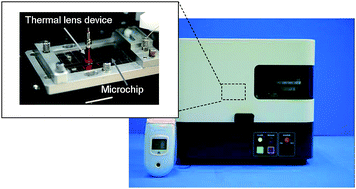A micro-ELISA system for the rapid and sensitive measurement of total and specific immunoglobulin E and clinical application to allergy diagnosis†
Abstract
We have developed a novel, practical micro-ELISA system for sensitive and rapid allergy diagnosis. The enzymatic reactions occurred under stopped-flow conditions, resulting in both high precision and high sensitivity. A BSA-biotin-avidin linker was introduced for the immobilization of water-soluble allergens on polystyrene microbeads, enabling immobilization of allergens in sufficient density to provide high sensitivity. Evaluation of the system's performance showed a good detection limit (2 ng/mL) for total IgE measurement. In addition, a good correlation with a conventional method (CAP method) was demonstrated using human serum samples from 85 allergy patients. Importantly, sample volumes (5 µL) were 10 times smaller and analysis time (12 min) was >20 times faster than the conventional method. All procedures were automatically regulated with our simple microfluidic system, and all the fluidic, optic and electronic components were integrated for portability. We believe that our system has the potential to become a very powerful tool, particularly for point-of-care diagnosis.


 Please wait while we load your content...
Please wait while we load your content...